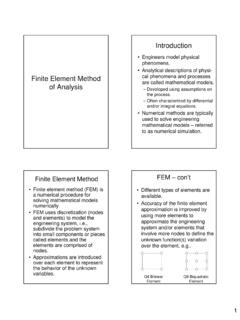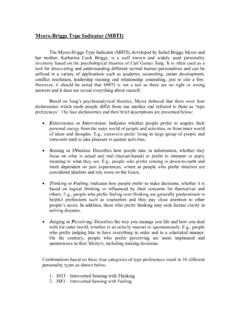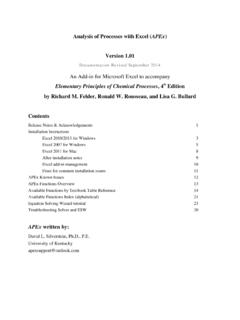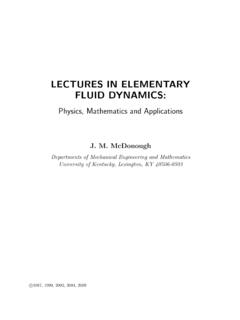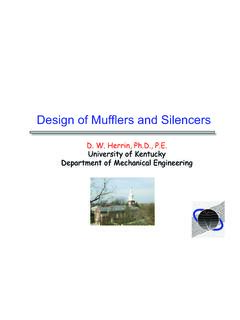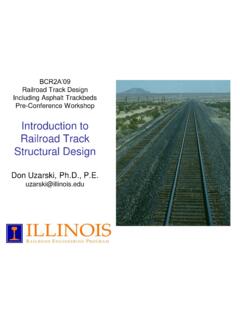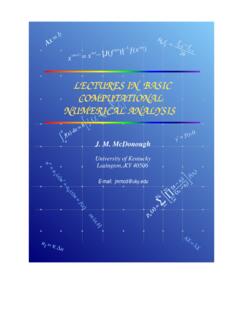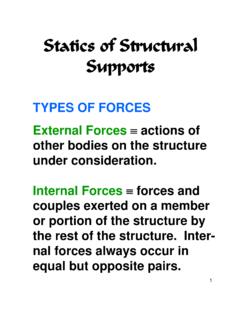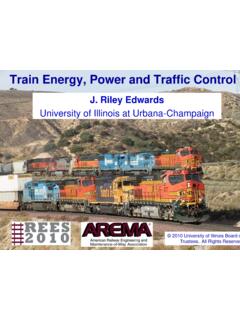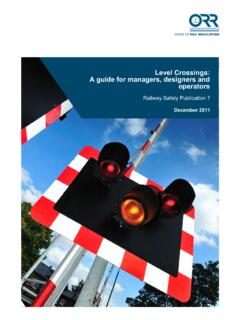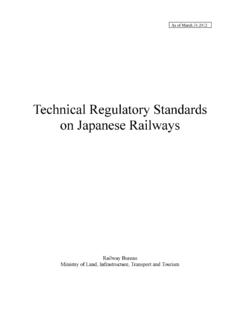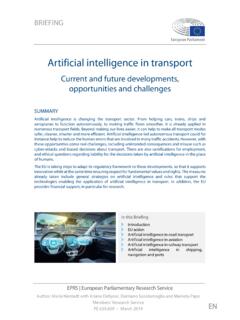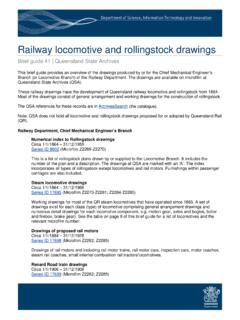Transcription of Introduction to Rail Transportation - University of Kentucky
1 Introduction to Rail Transportation Introduction Adequate Transportation System Efficient Movement of Goods and People Provides No Basic Intrinsic Value Provides Value Added Necessary for Economy and Development Early Modes of Transportation in the Waterways Crude Roads Rivers/Canals 1700 s Railroads 1830 Better Roads Trucks/Automobiles early 1920 s Air Passengers 1950s Interstates Trucks/Automobiles early 1960s Railroads 2000s!!! Current Modes of Transportation in the Waterways Highway Trucks Airways Pipeline Railways Conveyor Belts Railroads are America s First Large Corporations Had a Monopoly on Transportation Heavily Regulated until 1970s/1980s Railroads Privately Owned Railroads are Primarily Freight Rail Passenger Service is Heavily Subsidized by the Public Why is railroad freight transport so important now, and even more so in the future?
2 Lets consider the alternatives for inland transport: truck, water, air, pipeline, conveyor belt Waterways Pros and Cons Pros: Energy efficiency, low cost, low pollution, safety, capacity Cons: Speed, limited network Highway Truck Pros and Cons Pros: Speed, reliability, network coverage Cons: Energy efficiency, safety, land use, pollution, cost, congestion (because of shared use of infrastructure truck transport affects auto safety and congestion as well) How many truckloads can a railcar carry? Airways Pros and Cons Pros: Speed, reliability, network coverage Cons: Energy efficiency, cost, limited volume Pipelines and Conveyor Belts Pros: High volume, continuous transport possible, no vehicles needed, low labor requirements Cons.
3 Highly constrained types of commodities, limited product flexibility, speed and network Rail uniquely combines speed and energy efficiency *Plus environmentally Friendly Rail is the principal means of economically moving large, heavy freight long distances overland Freight Common Goals & Functions of the Railroad Industry The movement of Freight and People in the most efficient manner possible Principal Function in Hauling Freight (~43+%) Characteristics Fast Reliable Convenient Economical Safe/Secure Fuel Efficient Environmentally Friendly Renewed Interest in Passenger Rail Early Regulations Land Grants (1850-1870) Business Transactions Development of Central and Western Repaid Interstate Commerce Commission (1887) Surface Transportation Board (1995-1996) Recent Significant Legislation Phase 1: Passenger 1971 Amtrak Phase 2: Freight 1973 3R Act 1976 4R Act 1980 Staggers (Deregulation) Phase 3.
4 Multi-Modal 1992 ISTEA 1998 T21 2004 SAFETEA-LU 2008 Safety Improvements 2010 Surface Transportation Assistance Act (MAP 21 Moving Ahead Progress) North American rail network 6 large North American freight railroads CSX & NS in eastern US BNSF & UP in west CN & CP in Canada & central US KCS is a medium sized railroad in central US Amtrak operates passenger trains primarily on freight railroads trackage throughout US 16 (From Vantuono 2000) Major freight railroads North American freight Transportation volume by mode 0 2 0 0 4 0 0 6 0 0 8 0 0 1 0 0 0 1 2 0 0 1 4 0 0 1 6 0 0 R a i l T r u c k P i p e l i n e W a t e r w a y s A i r Billions of Ton-Miles Rail Truck Pipeline Waterways Air Source: AAR from Eno Foundation for Transportation 0200400600800100012001400160018002000192 0193019401950196019701980199020002005200 8 Revenue Ton-Miles (billions) Year US rail freight traffic The Fundamental Principle of Rail Transport - EFFICIENCY Implications for Economics, Energy & Environment or Why Rail Transport is More Important Than Ever!
5 US 20th Century was about CONVENIENCE The 21st must consider EFFICIENCY as well Then Abundant: energy, land, natural resources and labor Now Diminishing resources: Energy Air quality Water Land Congestion Need more efficient use of Transportation infrastructure Stronger global competition Energy efficiency truck vs. rail How far can each mode transport a given amount of freight for a given amount of energy? Specifically, how far can we transport one ton of freight with one gallon of diesel fuel? (AAR & FRA data) Rail is over 3 times more efficient than truck Increased Public Interest in Rail Increased awareness of rail as a solution to congestion, pollution, and fuel inefficiency Increased motivation to invest public money in rail infrastructure Heartland CREATE Green Power (Locomotives) I81 Genset and Hybrid Switchers In the last 20 vehicle travel increased 78% Road miles increased only 1% Traffic congestion costs the $67 billion annually Intermodal Definition Intermodal shipment: a freight shipment that moves between origin and destination using two or more modes of Transportation Two types of intermodalism.
6 Bulk Unitized Growth of unitized intermodal shipments has been a spectacular trend in Transportation Domestic and internationally standardized designs for containers Intermodal freight Containers Intermodal Transportation by more than one means of conveyance, as by truck, ship and/or rail Trailers Basic types of unitized intermodal equipment & service Railroad intermodal Transportation is typically described as either: Trailer on flatcar (TOFC) Container on flatcar (COFC) Although the early railcars used to transport these were flatcars, intermodal rolling stock has become highly specialized Also RoadRailer , is a system in which a container can ride directly on either highway or railroad wheel assembly, without any car at all Summary Rail Industry is growing Rail has become a viable alternative to truck Spike in Public Interest due to Highway congestion Population growth Environmental issues Fuel Conservation Significant investment required to accommodate growth for freight and passenger Passenger Rail Service Intercity Passenger Rail trains that move passengers between cities long distances.
7 High speeds High Speed Passenger Rail Short to medium distance intercity rail Urban Rail Transit trains that move passengers within a city/urban area OR between the suburbs and the central city several types of urban rail transit modes Amtrak Rail Network Acela Express operates in Northeast Corridor Top speed 150 mph Average = 82 mph W-NY 68 mph NY-B Auto Train operates between Virginia and Florida 855 miles, 17 hrs, 49 mph High Speed Rail (HSR) a rail line and service designed for high speed operation - cruising speed of 125+ mph Japanese introduced the first high speed trains in the mid 1960s Shinkansen (Bullet Train) today high speed rail lines are common in France, Germany, Spain, United Kingdom, and many other countries Skinkansen (Bullet Train) in Japan Intercity Express (ICE) - Germany British Rail High Speed Trains French TGV 574 km/hr (357mph) test High Speed Rail in the United States Amtrak Acela Express Northeast Corridor, top speed 150 mph several high speed rail corridors studied US DOT Federal Railroad Administration URBAN RAIL TRANSIT rail service in urban applications operates in a city OR between the suburbs and the central city several types of urban rail transit modes Commuter Rail Rail Rapid Transit (Metro)
8 Streetcars and Light Rail Transit Commuter Rail Chicago Metra 42 Rail Rapid Transit (Metro) high speed, high capacity trains multi-car trains operate on short headways (some can operate at 2 minutes or less) electric power taken from a third rail exclusive right-of-way underground, elevated, at-grade sophisticated signaling variety of other names Metro, Subway, Underground, Heavy Rail Chicago Washington Metro Light Rail Transit (LRT) a new name for the streetcar electrically powered vehicles, but may link two or more vehicles to form a train a variety of operating strategies: share the road transit only street Transitway, Transit Mall on a separate right-of-way on the surface, underground, or an elevated structure typically have honor fare collection Light Rail Transit Minneapolis Hiawatha Line Streetcars electrically powered vehicles that share the road with other traffic - power is from an overhead wire (trolley or pantograph) first demonstrated at expositions in Chicago and Toronto late 1800s several developers/inventors (including Thomas Edison) also called Tram, Trolley, Street Railway Streetcars Automated Guideway Transit Downtown People Mover (DPM)
9 Several research initiatives in the 1980s three systems built Jacksonville Miami Detroit Opportunities Railway Transportation (Engineering and Operations) Area of Study University of Kentucky Technical Elective Classes CE 433 CE 533 CE 599 Assist on Funded Research Undergraduate Graduate Co-Op and Intern Positions Department of Civil Engineering Department of Civil Engineering Graduate Students Since 1996=45 (Also 25 undergraduates) Numerous Funded Research Projects National Asphalt Pavement Association/Asphalt Institute L & N Railroad/Santa Fe Railway CSX Transportation Association of American Railroads Kentucky Transportation Cabinet Norfolk Southern Corporation Nichols Foundation BNSF Railway P-Cell 209 on 5 in.
10 HMA Layer 051015207891011121314151617 Time (s)Pressure (psi)4 6-Axle Locos Initial 5 Cars Empty Coal Train at Conway In Track Placement During First Test Scale in PSI Typical Pressure Distribution Plot from Tekscan System Resilient Modulus 25 C (77 F) 1Hz TriMet, Oregon Caltrains Los Angeles Metrolink Iowa DOT Indiana DOT West Virginia DOT Tennessee DOT Hillsborough County, FL KY DOT Michigan DOT Kentrack Kentrack is a computer program designed to analyze a railroad track segment as a structure Uses Bousinessq s Elastic Theory Uses Burmister s Multi-Layer System and Finite Element Analysis to perform calculations International Design Practices, Applications, and Performances of Asphalt/Bituminous Railway Trackbeds Dr.
